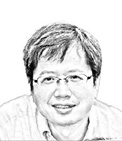Exhibition makes clear potential of glass artwork
Art is created in the medium of glass by blowing, casting, carving and smashing the material, among other methods, to create works of beauty.
Breathing through Transparency — International Contemporary Glass Art Exhibition shows 100 pieces from glass sculptors from home and abroad.
Glass is not just transparent panes here but is revitalized and represents thoughts and aesthetics. There are mostly classical and signature works by about 30 artists from Australia, the United Sates, Germany, France, England and China.
Running to March 5 at the Gallery of the China Academy of Art in Hangzhou, the exhibition is organized by the China Academy of Arts, and is curated by Xu Jiang, the principal of the academy, and Richard Whitely, head of the Glass Workshop at the School of Art of the Australian National University.
Silicate has been used in glassworks in China for many centuries, but now the variety and panorama are changing and expanding.
“I want to help introduce glass art into China ... glass is viewed as a new idea and possibility,” Whitely told Shanghai Daily.
Xu’s exhibited work “Sunflower” is a molded glazed glasswork with atmospheric light in shadings of orange and green. It has been exhibited at West Lake in Hangzhou for the past year.
The work accords with the style of the traditional Chinese art liu li, in which silicate is fired for glazed, semi-transparent works, with a history of over 1,000 years in the country. But Xu’s work features better transparency.
“Chinese people invented the making of glass a long time ago, but focused more on making ceramics,” said Xu. “The two arts are somewhat associated, and that is why glass art needs support in today’s China.”
Whitely has brought four classical pieces, including “Eclipse Step,” a work composed of two colored glass blocks, one transparent brown and one transparent silver, both featuring ridged stripes with an earthy, weathered look on the facade, and a halo in the center.
“Eclipse Step” and his other works are recently made, and one feature is that very few bubbles are seen in the glass despite the fact that they are rather thick.
“To leave a few bubbles reminds you that it is the material — glass — but too many bubbles is not good,” the sculptor said. He casts hot glass into molds to avoid too many bubbles, just like bronze casting.
It requires a long finishing process, and thicker the glass is, the longer it takes. Whitley’s “Eclipse Step” (55cm by 81cm by 30cm per piece) takes three weeks to cool down.
On the other hand, some works are purposely made with bubbles that are organized as the artist wishes.
Hong Kong artist Sunny Wang’s work “Almost Self” is shaped like a transparent cardinal heart atop an egg, and in the egg is embedded a string of bubbles. The entire work looks like crystal because of its transparency and the light cast from the bottom.
“To embed bubbles at the right place in glass sculpture is as difficult as avoiding bubbles,” said Guan Donghai, a glass sculptor whose works are shown at the exhibition.
He said that because of the difficulties of firing, shaping, carving and making or not making bubbles, the success rate of making a good glass sculpture is lower than for creating other artwork. Some crack after firing.
“To be a glass sculptor, one needs to love glass as a material very much,” Guan said.
While part of works are still easily identifiable as glass and play games with light, some are of other styles.
American artist Amber Cowan’s piece “Rosaline Swan Triptych,” boasting swirling and mesmerizing flowers and a swan, is of a texture that looks alike soap, but it is a mixture of broken glass pieces and plaster.
Cowan smashes old glass knickknacks she collects from markets and garage sales, and fires them into intricate art pieces.
Guan’s “City Wall” series of works looks a bit like rusted metal.
The work is in the shape of ancient Chinese-style city walls with an arched gate below and a lookout tower on top, and Guan at places “applied copper powder” and at others used “tinfoil paper” to “create an archaic feel.”
Some works are even “woven” — “Angle is Waiting” by Chinese artist Xue Lu is a pair of wings woven from glass tubes, and German artist Klaus Moje’s works “Roll Up” and “Square Form” are fused from glass rods cut into thin wafers or strips
Participating foreign artists also include Nick Mount (Australia), Danial Clayman (US), Nadege Desgenetez (France) and Heike Brachlow (UK). The exhibition commemorates the 30th anniversary of the Australian Consulate General’s founding in Shanghai.
Date: Through March 5
Address: 218 Nanshan Rd
- About Us
- |
- Terms of Use
- |
-
 RSS
RSS - |
- Privacy Policy
- |
- Contact Us
- |
- Shanghai Call Center: 962288
- |
- Tip-off hotline: 52920043
- µ▓¬ICPĶ»ü’╝ܵ▓¬ICPÕżć05050403ÕÅĘ-1
- |
- õ║ÆĶüöńĮæµ¢░ķŚ╗õ┐Īµü»µ£ŹÕŖĪĶ«ĖÕÅ»Ķ»ü’╝Ü31120180004
- |
- ńĮæń╗£Ķ¦åÕɼĶ«ĖÕÅ»Ķ»ü’╝Ü0909346
- |
- Õ╣┐µÆŁńöĄĶ¦åĶŖéńø«ÕłČõĮ£Ķ«ĖÕÅ»Ķ»ü’╝ܵ▓¬ÕŁŚń¼¼354ÕÅĘ
- |
- Õó×ÕĆ╝ńöĄõ┐ĪõĖÜÕŖĪń╗ÅĶÉźĶ«ĖÕÅ»Ķ»ü’╝ܵ▓¬B2-20120012
Copyright ┬® 1999- Shanghai Daily. All rights reserved.Preferably viewed with Internet Explorer 8 or newer browsers.


